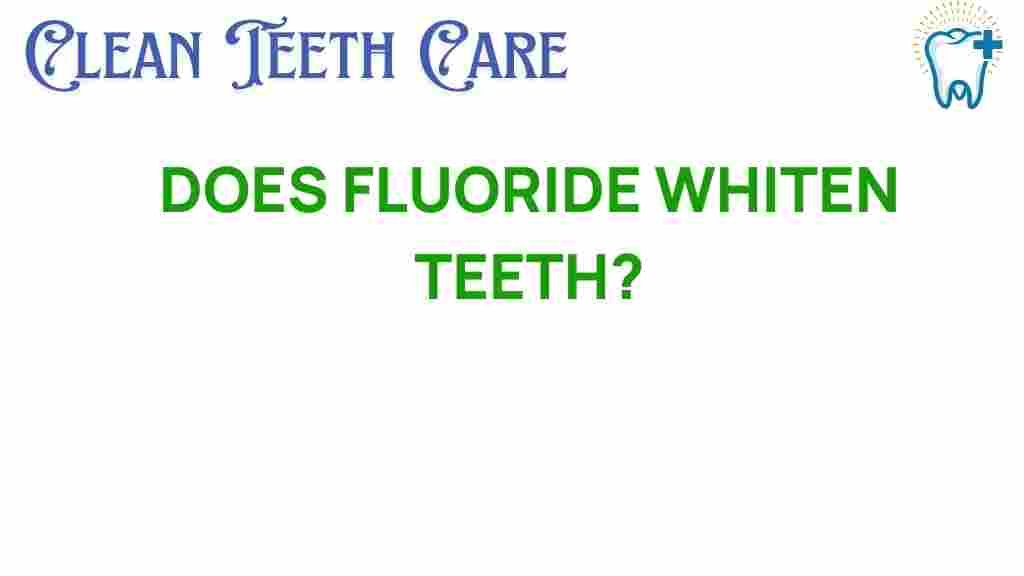The Truth Behind Fluoride: Can It Really Whiten Your Teeth?
Fluoride has been a topic of debate for decades, particularly in the realm of dental health and oral hygiene. Many people wonder whether fluoride can actually whiten your teeth or if it merely serves other purposes in maintaining dental health. In this article, we will explore the truth behind fluoride, its role in teeth whitening, and address some common misconceptions surrounding this important mineral.
What is Fluoride?
Fluoride is a naturally occurring mineral that is found in various sources, including water, soil, and certain foods. It is well-known for its benefits in dental health, particularly in preventing tooth decay. When fluoride is applied to the teeth, it helps to remineralize the enamel, making it more resistant to decay.
The Role of Fluoride in Dental Health
Fluoride plays a crucial role in maintaining dental health. Here are some of the primary benefits:
- Prevents Tooth Decay: Fluoride strengthens the enamel, making it more resistant to acid attacks from bacteria and sugars.
- Remineralization: It helps in the remineralization of early-stage cavities, reversing damage before it becomes a serious issue.
- Reduces Sensitivity: Fluoride treatments can help reduce tooth sensitivity by strengthening the enamel.
Can Fluoride Whiten Your Teeth?
The question on many people’s minds is whether fluoride can actually whiten teeth. The answer is nuanced. While fluoride itself does not have whitening properties like some over-the-counter whitening treatments, it can contribute to a brighter smile in several indirect ways:
- Strengthens Enamel: Stronger enamel reflects light better, which can make teeth appear whiter.
- Prevents Stains: By keeping enamel healthy and preventing decay, fluoride can indirectly help maintain the natural whiteness of teeth.
- Supports Oral Hygiene: Good oral hygiene practices that include fluoride can lead to less plaque buildup, which can keep teeth looking cleaner and brighter.
Misconceptions About Fluoride and Teeth Whitening
Despite its benefits, several misconceptions about fluoride and its role in teeth whitening persist. Let’s clarify some of these:
- Myth 1: Fluoride whitens teeth like bleaching agents.
Truth: Fluoride does not bleach teeth; it strengthens them. - Myth 2: More fluoride means whiter teeth.
Truth: Excessive fluoride can lead to fluorosis, which can cause discoloration. - Myth 3: Fluoride is harmful to dental health.
Truth: When used appropriately, fluoride is safe and beneficial.
Fluoride Treatments: What to Expect
Fluoride treatments are commonly administered by dentists as part of routine dental care. Here’s what you can expect during a fluoride treatment session:
- Consultation: Your dentist will discuss your dental health and determine if you need fluoride treatment.
- Application: Fluoride can be applied as a gel, foam, or varnish. The application typically takes just a few minutes.
- Post-Treatment Care: After the treatment, you may be advised to avoid eating or drinking for at least 30 minutes to allow the fluoride to absorb into the teeth.
At-Home Fluoride Options
In addition to professional treatments, there are several at-home fluoride options available:
- Fluoride Toothpaste: Most toothpaste contains fluoride, which helps in daily protection against cavities.
- Fluoride Mouthrinse: Over-the-counter fluoride mouthwashes can provide an additional layer of protection.
- Prescription Fluoride Products: If you are at higher risk for cavities, your dentist may prescribe stronger fluoride treatments.
Combining Fluoride with Other Teeth Whitening Treatments
If you are interested in achieving a whiter smile, you might consider combining fluoride with other teeth whitening methods. Here are some popular treatments:
- Whitening Toothpaste: These often contain mild abrasives and other agents designed to remove surface stains.
- Over-the-Counter Whitening Strips: These thin strips are coated with a peroxide-based gel that can lighten teeth over time.
- Professional Whitening Treatments: Dentists offer stronger whitening options that provide faster results.
How to Maintain a Bright Smile with Fluoride
To keep your smile bright, it’s essential to follow good oral hygiene practices:
- Brush Twice Daily: Use fluoride toothpaste to brush your teeth at least twice a day.
- Floss Daily: Flossing helps remove plaque and food particles that brushing may miss.
- Regular Dental Visits: Schedule regular check-ups with your dentist to monitor your dental health.
- Limit Staining Foods and Drinks: Reduce consumption of coffee, tea, and red wine, which can stain teeth.
Troubleshooting Common Issues
If you experience any issues with fluoride treatments or teeth whitening, here are some troubleshooting tips:
- Tooth Sensitivity: If you notice increased sensitivity after using fluoride or whitening products, consult your dentist.
- Uneven Whitening: This can occur if some areas are not treated equally. Professional treatments typically ensure even application.
- Fluorosis: If you notice white spots on your teeth, consult your dentist, as this may indicate overexposure to fluoride during childhood.
Consulting Your Dentist
Before starting any fluoride or teeth whitening treatments, it is always best to consult your dentist. They can provide personalized advice based on your dental health and recommend the best course of action for achieving a brighter smile. If you’re looking for more information, check out this external link for a comprehensive overview of fluoride.
Conclusion
In summary, fluoride plays a significant role in dental health and can indirectly contribute to maintaining a brighter smile. While it may not whiten teeth in the same way that other treatments do, its ability to strengthen enamel and prevent decay is invaluable. By understanding the truth behind fluoride and dispelling common misconceptions, you can make informed decisions about your oral hygiene practices. Remember to always consult with your dentist to find the best treatments for your needs and to keep your smile healthy and bright.
For further reading on maintaining your oral hygiene and dental health, visit our internal link for expert tips and advice.
This article is in the category Treatments and created by CleanTeethCare Team
